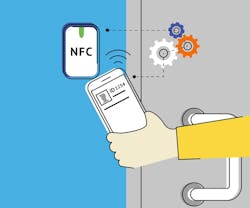Report: Access to Apple's NFC chip could spur new growth in mobile access credentials
The security industry has been abuzz in recent years as it pertains to the benefits presented by mobile access control solutions, but while the ability to more easily manage credentials and do away with traditional card-based technologies is appealing to many organizations, the fact remains that the growth in adoption of mobile access control solutions has been slow.
However, according to new research from IHS Markit, the technology is expected to get a shot in the arm over the next several years due to several market drivers. In fact, while fewer than one million mobile credentials were downloaded by end-users in 2016, Jim Dearing, senior analyst for building and security technology at IHS Markit, said in a research note published last week that that number is expected to increase rapidly over the next five years, reaching 44 million downloads by 2021.
“The reason for the strong growth is two-fold,” wrote Dearing. “Market sentiment reveals that the use of mobile credentials in access control is not only a strong value proposition on its own, but it also holds the potential to unlock a more integrated and better value system for the end-user while also creating new services that can support new revenue streams for providers of mobile access going forward. Also, mobile credentials are currently not competing against physical cards, but instead are being marketed as a complement to traditional offerings; therefore, the potential market is much larger.”
Dearing said that the end-users who are the most likely to adopt a full mobile credential-only system are those that have to deal with large numbers of temporary visitors or who have exceptionally high card turnover rates, such as building sites where contractors need access to varying locations as well as universities and hotels that have to replace large numbers of cards every year.
In addition, Dearing said that the adoption rate of mobile-capable readers currently far surpasses that of mobile credential downloads. This is due to the fact that a significant portion of the access control smart card reader installed base is mobile capable by default and also because many organizations are deploying mobile-capable readers despite having no intention of using mobile credentials in the near future simply as a way to future-proof their systems.
Installed Base of Mobile-Capable Readers Still Growing
In 2016, Dearing said that just seven percent of non-residential access control readers shipped were mobile capable. However, global shipments are forecast to grow to around 20 percent by 2021.
The Americas region is the most mature market in terms of adoption of mobile-capable readers, according to Dearing. In 2016, over 17 percent of access control readers shipped in the region were mobile capable.
Among the reasons shipments of mobile-capable readers are rising include:
- A growing number of smart card readers are becoming mobile capable by default as manufacturers add NFC mobile communication functionality — often at no additional cost to the end-user.
- Access control manufacturers are adding readers to their offerings with Bluetooth modules that can be used for mobile communication, or they are selling Bluetooth module add-ons separately.
Dearing said that smart card readers are by far the most common type of mobile-capable reader, accounting for 98.5 percent of mobile-capable reader unit shipments in 2016.
iOS 11 Presents New Opportunities for NFC
One of the reasons most often cited among industry experts as to why mobile access hasn’t taken off more quickly is due to Apple’s reluctance to allow vendors access its near-field communication (NFC) chip. As a result, the majority of suppliers turned to Bluetooth Low Energy (BLE) as the preferred format of choice.
However, Dearing says that with the release of iOS 11 in September, Apple opened up access to the NFC chip in the iPhone 7 and 7 Plus, as well as future iPhone generations.
“This has huge potential to reinvigorate interest from mobile access providers in NFC-based smartphone communication,” wrote Dearing. “Historically, using the payment market as an example, the use of mobile-based contactless payments started to gain market share rapidly only after Apple launched Apple Pay.”
Dearing said that a similar scenario could play out in the access control market for several reasons including:
- End-users, after experiencing the payment and transportation ticketing migrations, are now very familiar with the NFC process and could be easily educated about the use of NFC in the access control space.
- Many mobile access providers in the market today are access control equipment manufacturers that have vast amounts of experience working with similar technology through their production of MIFARE smart card readers.
Even with increasing adoption of both mobile credentials and readers, Dearing said that providers have yet to settle on a particular business model. For example, some providers are opting to charge the end-user directly for the credentials, while others are trialing subscription-based pricing models. Some are also giving away the mobile credentials for free.
“Providers that are not charging for mobile credentials are hoping to use this as a unique selling point to win key projects or increase their share of the reader equipment market,” said Dearing. “IHS Markit expects that as the number of suppliers that are providing mobile credentials for free grows, the average selling price of the credentials will decrease as other companies lower their prices to stay competitive.”
For more information or to learn how you can download a copy of IHS Markit’s, “Access Control Intelligence Data – Mobile Credential – 2017” report, click here.
